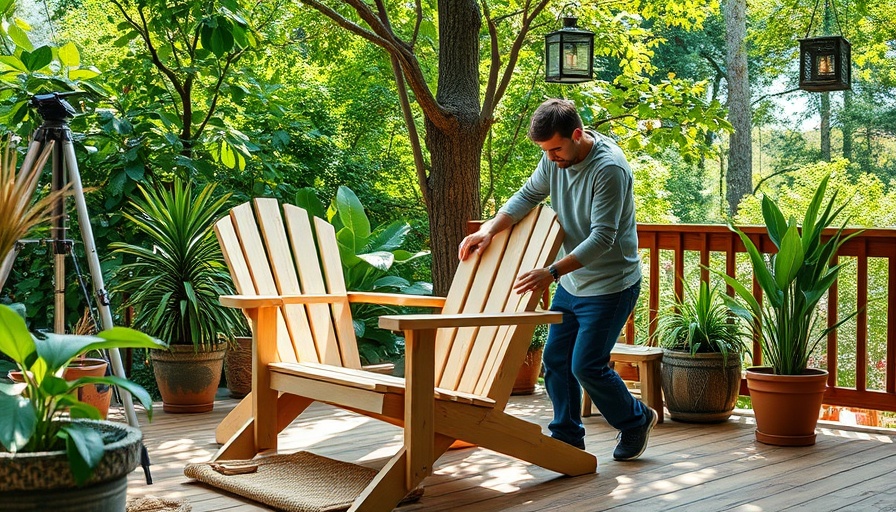
The Joy of Creating Your Own Solid Oak Furniture
Have you ever thought about transforming your living space with stunning, handmade furniture without breaking the bank? Many individuals are finding that the joy of DIY furniture construction not only fits a tighter budget but also enriches their homes with unique character. Inspired by a fascinating video titled Making A Solid Oak Chair On A Budget, we delve into the exciting world of crafting furniture from repurposed materials like old wine barrels, offering creative insights into home building that resonate profoundly with the community spirit.
In Making A Solid Oak Chair On A Budget, the discussion dives into transforming wine barrels into beautiful furniture, exploring key insights that sparked deeper analysis on our end.
Transforming Unused Materials into Beautiful Furniture
In the video, the host skillfully demonstrates the process of repurposing a classic wine barrel into an elegant chair, showcasing not just craftsmanship but also an innovative approach to sustainability. These barrels are often discarded or available at low costs from local retailers like Bunnings. Whether you want a unique chair or need a new coffee table, using materials that would otherwise go to waste can make your creation not only budget-friendly but also an environmental win.
Why DIY Furniture is Worth the Investment
Crafting your own furniture allows for personalized designs tailored to your home’s aesthetics. As featured in the video, simple measurements and thoughtful planning can lead to stunning results—an astonishing chair and side table made from a single wine barrel! Surpassing the cookie-cutter appeal of mass-produced furniture, these handmade pieces tell a story and become conversation starters in your home.
Utilizing Local Resources for Your DIY Projects
What's better than a shopping spree? Scouring your local community for materials! Not only does this foster relationships with local businesses, but it offers the chance to provide your home with a true reflection of where you live. Many neighborhoods have recycling initiatives, and checking estate sales can lead to discovering unique treasures. Each piece can be treated and crafted to add character to your space.
Planning and Design for Your DIY Enthusiasts
Before diving into your project, it's crucial to draft a plan. Knowing the dimensions of a standard chair and making adjustments for comfort can help streamline your build. Learning proper techniques, such as mitering edges or choosing between stains and clear coats as discussed in the video, can elevate your project. The satisfaction of seeing your design come to life from sketches to a fully functional piece is unmatched.
A Sustainable Approach to Home Decor
With growing awareness around sustainability, upcycling furniture supports eco-friendly lifestyles. The video showcases not just making a chair, but also a side table that lives up to the allure of solid oak while significantly reducing waste. Embracing this green mindset nurtures creativity and enhances your living space while contributing positively to the environment.
Bringing Community Spirit to Your Crafting
Beyond personal gain, DIY furniture encourages community bonding. Inviting friends and family to join you in a project can be a fun experience that fosters connections. As you share stories, laughter, and shared efforts, you cultivate not just products but memories and stronger relationships. Imagine crafting an heirloom that doubles as a memory—a piece made collectively that gets passed down through generations!
Tips for Those New to DIY Furniture Projects
For anyone considering embarking on DIY furniture, here are some helpful tips:
- Start Simple: Choose a project that matches your skill level, such as a stool or side table.
- Gather Your Tools: Basic tools include a saw, drill, and sander. Ensure you’re equipped for safety as well.
- Incorporate Nature: Use reclaimed wood or eco-friendly materials to create stunning designs.
- Join a Workshop: Community workshops can offer guidance and resources for beginners.
- Document Your Progress: Capture the journey to appreciate the transformation and to inspire others.
Final Thoughts
Bringing the art of DIY to life through furniture creation can be incredibly rewarding. Whether you’re creating a chair or sprucing up your garden with flower beds, the ability to personalize your space not only beautifies your home but serves as a powerful expression of you and your creative spirit. Now, let’s get crafting and make those dreams a reality!
If you're ready to roll up your sleeves and embrace the joy of creating your own solid oak furniture, don’t hesitate to explore further how to bring your ideas to life with DIY projects!
 Add Row
Add Row  Add
Add 




Write A Comment